Prices and Availability Subject to Change. Please call 800-997-4311 for more Information.

1850s Men's Fashion Guide
As the world stepped into the 1850s, a revolution in men's fashion was brewing, fueled by technological advancements that would forever change the landscape of clothing production. The decade marked a pivotal moment in history, where the marriage of science and style gave birth to a new era of accessible fashion.
The sewing machine, a marvel of engineering, took center stage in this transformation. In 1851, Isaac Merritt Singer patented his foot-powered sewing machine, combining earlier designs to create a practical and affordable solution. This invention dramatically reduced the time required to produce garments; a man's shirt that once demanded 10-15 hours of painstaking handwork could now be completed in a mere hour. The impact was profound, driving down clothing prices and democratizing fashion like never before.
But the sewing machine was not alone in revolutionizing the industry. The decade saw a flurry of innovations that would shape the future of clothing. In 1851, Elias Howe Jr. patented the first zipper-style fastener, though it would take decades to perfect. The same year, James King introduced the first drum washing machine, laying the groundwork for modern laundry appliances. The charcoal iron, patented in 1852, offered a more efficient and safer alternative to its predecessors, allowing for better garment care and presentation.
Perhaps the most colorful innovation of the decade came in 1856 when William Henry Perkin accidentally created the first synthetic dye, aniline purple or mauve. This discovery ushered in an era of vibrant, affordable fabrics that would soon capture the imagination of fashion enthusiasts across social classes.
These technological leaps coincided with societal changes, creating a perfect storm for fashion evolution. The expansion of ready-to-wear menswear, epitomized by the establishment of Brooks Brothers in New York in 1850, meant that for the first time, men of all classes could access fashionable clothing with ease. By the end of the decade, the once stark divide between the appearances of the wealthy and the working classes had significantly narrowed.


The Silhouette of the 1850s Gentleman
The 1850s witnessed a gradual but dramatic shift in men's fashion silhouettes. The decade began with the narrow, form-fitting styles inherited from the 1840s, but by mid-decade, a bold new look emerged. This transformation mirrored the changing times, as men's fashion began to echo the fuller silhouettes seen in women's wear.
Early in the decade, gentlemen still favored narrow coats with tightly fitting sleeves and trousers. However, as the years progressed, a more relaxed and comfortable style took hold. Coats became boxier, with looser sleeves and wider lapels. Trousers, too, adopted a looser fit, offering greater comfort and ease of movement.
This evolution in style was not merely aesthetic; it reflected the changing attitudes and lifestyles of the era. The influence of English country style, which had been gaining popularity since the turn of the century, continued to shape men's fashion. However, the 1850s added its own unique flair, blending practicality with a touch of flamboyance.



Frock Coats
The frock coat reigned supreme as the defining garment of the 1850s gentleman. Worn for most daytime occasions and certainly for formal wear, it embodied the essence of mid-19th century style. Unlike its predecessors, the frock coat of the 1850s was cut straighter, with the requisite waistline seam and falling to around knee-length. This silhouette created a more streamlined appearance reminiscent of the narrow styles of the 1830s. However, by 1854 frock coats began to loosen in fit with wider lapels and a much lower collar which was often made of velvet.


Morning Coats
Previously reserved for riding or casual settings, the morning coat (aka a cutaway coat) gained acceptance as an alternative to the frock coat for daywear. Constructed similarly to a tailcoat but without the front cutout, the morning coat's opening sloped gently down to the hem, creating an elegant line. Reflecting the same style sensibilities of the frock coat, the morning coat was slimly cut in the early 1850s and more generously sized as the decade progressed. This style of cost would continue to evolve, eventually becoming a staple of formal morning dress in later decades.

Sack Coats
Emerging in the 1840s, the sack coat came into its own during the 1850s. This relaxed style, finishing at the hips and lacking a waist seam or back shaping, became the go-to choice for casual occasions and sporting events. The sack's popularity also grew among the lower classes to become the standard for men's workwear.

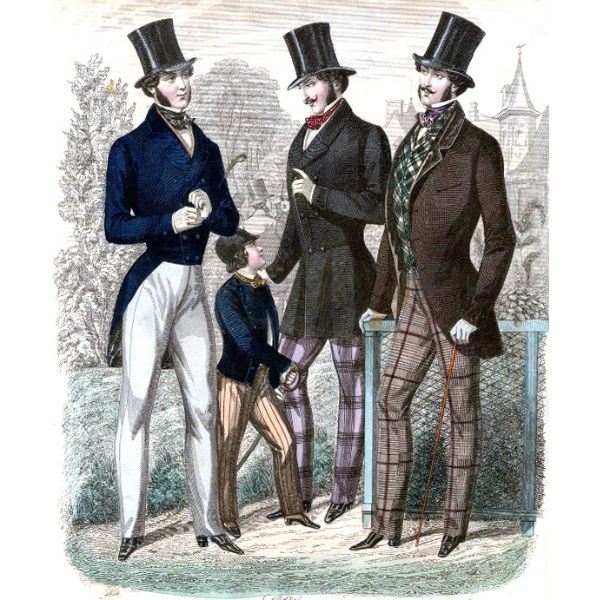
Tail Coats
While the tailcoat's dominance had waned since the early part of the century, it still held its place for evening wear and full dress occasions. Usually single-breasted and designed to be worn open, the tailcoat allowed for the display of an often elaborately decorated waistcoat beneath. By the end of the decade, however, its use was increasingly confined to formal evening events, signaling the end of an era in men's fashion.


Overcoats
As the ready-to-wear industry flourished, overcoats, also known as "top frocks," became increasingly accessible to gentlemen across social classes. The 1850s witnessed the rise of several defining overcoat styles that would come to epitomize late Victorian outerwear. Chief among these was the Chesterfield coat, a versatile garment that balanced elegance with practicality. Typically crafted from heavy wool, the Chesterfield featured a velvet collar, often in a contrasting color, adding a touch of sophistication. Some variations incorporated braid closures or even fur trim for added luxury.
These coats, cut generously to accommodate the layers worn beneath, provided both warmth and style, allowing gentlemen to maintain their fashionable appearance even in inclement weather. The popularity of overcoats during this period reflected not only practical needs but also the growing importance of outdoor activities and urban life in Victorian society.
Smoking Jackets
The smoking jacket emerged as a quintessential garment of leisurewear in the 1850s, reflecting the increasing popularity of tobacco use among gentlemen. Designed to be worn at home, these jackets served several purposes. They were worn for at home comfort but were also used to protect one's clothing from ash and the pervasive scent of tobacco.
The typical smoking jacket of the era drew inspiration from the kaftans of the Ottoman Empire, featuring a relaxed fit and often elaborate decorations. Luxurious versions were crafted from velvet or quilted silk, boasting contrasting linings that added a pop of color when the jacket was in motion. More modest interpretations utilized flannel in contrasting colors, adorned with braid trim and secured with ornamental frog closures. Often paired with a matching smoking cap, these jackets became a symbol of a gentleman's private time, worn when retiring to the smoking room after dinner or during quiet evenings at home. The smoking jacket's popularity underscored the Victorian era's emphasis on specific garments for every occasion, even within the confines of one's own home.




Vests
The 1850s saw a resurgence of double-breasted vests, complete with widening lapels and rising necklines to accommodate the higher placement of ties. Single-breasted styles remained popular as well, with both versions cut either straight across the waist or tapering to points at the center front.
Vests of this era reflected the technological advancements in textile production. Thanks to improved loom technology and the introduction of aniline dyes, waistcoats became a riot of color and pattern. Intricately woven fabrics, often in glossy silks, and a vast array of vibrant hues allowed gentlemen to express their personal style even as their coats became more somber.
The contrast between colorful vests and darker coats became a hallmark of 1850s men's fashion. Dress vests, in particular, embraced this trend, while daytime and work vests tended towards darker wools for winter and lighter linens or cottons for summer.


Shirts and Ties
Shirts of the 1850s maintained their traditional white color for both day and evening wear. However, the rise of ready-made clothing brought with it a wider variety of options, including colored stripes, checks, and small patterns. The decade also saw the introduction of both attached and detachable collars and cuffs, a practical innovation that allowed for easier laundering of these high-wear areas.
The fashion for extremely tall collars, popular in previous decades, gave way to a lower-sitting style. By the end of the 1850s, it became common to see shirt collars turned down over the tie, a look that would persist well into the next century.
Neckwear, too, saw significant changes. The flowing, elaborate cravats of earlier eras fell out of favor, replaced by simpler styles. Many men preferred a silk square folded to create a mid-sized band and finished with a neatly tied, flat bow. These ties appeared in a variety of colors and patterns, with checks being particularly fashionable. For more casual or work attire, skinny ribbon neckties gained popularity.

Trousers
The evolution of trousers during the 1850s mirrored the overall shift in men's fashion silhouettes. Early in the decade, pants remained slim, echoing the narrow aesthetic of the 1840s. However, as the years progressed and the general silhouette for menswear broadened with looser pants becoming the norm.
By mid-decade, gentlemen had two primary options: trousers with straight-cut legs or those tapering to the ankle. A significant change came in the construction, with pants now featuring a single button fly at the center front rather than the fall front flap of yesteryear. The instep strap, a hallmark of earlier decades, disappeared as trousers lengthened, now breaking over the shoes in a modern silhouette.
In a departure from the somber tones of earlier years, trousers of the 1850s embraced a wide array of patterns and colors. Plaids, checks, stripes, and lighter hues became extremely popular, rarely matching the coat or vest. This mix-and-match approach added depth and interest to a gentleman's ensemble, though darker pants remained common, especially for workwear.

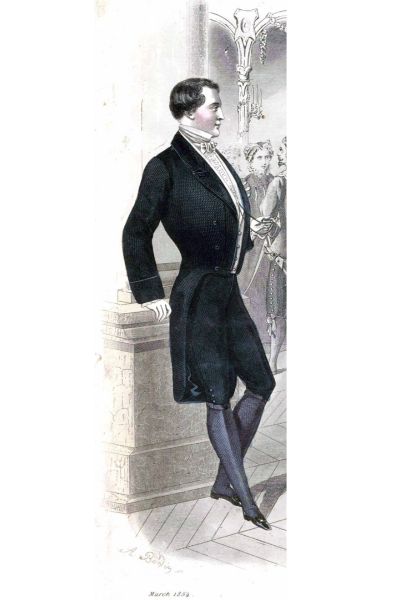
Evening Wear
As the sun set, the 1850s gentleman transformed into a vision of formal elegance. The centerpiece of evening wear remained the black tailcoat, worn over a white shirt with a finely pleated and stiffly starched bib front. Beneath this, a white waistcoat provided a crisp contrast, while a white stock or cravat adorned the neck.
Black trousers and polished black leather dress shoes completed the lower half of the ensemble. Atop it all sat the ever-present black silk top hat, the crowning glory of a well-dressed Victorian gentleman.
As the decade progressed, fashionable men increasingly donned overcoats for evening outings. A fur-trimmed Chesterfield coat or a thigh-length cape trimmed with braid offered both warmth and an additional layer of sophistication, especially for attending the opera or other high-society events.


Hats and Hairstyles
The top hat, a staple of men's fashion since the turn of the century, reached new heights in the 1850s - quite literally. Made from glossy black silk, these hats grew ever taller as the decade progressed, setting the stage for the towering "stovepipe" styles that would become iconic in the early 1860s.
While the top hat reigned supreme for formal occasions, a variety of other headwear options emerged for daytime use. The felt wide-awake hat, with its tall crown and wide, stiff brim, offered a more casual alternative. Young men and boys often opted for caps, while travelers might don caps with earflaps for added warmth and protection.
The 1850s also saw the introduction of the stiff felt bowler or derby hat. Initially positioned as an alternative to the top hat for business and city engagements, the bowler would go on to replace the top hat as standard headgear in the late Victorian and Edwardian eras.

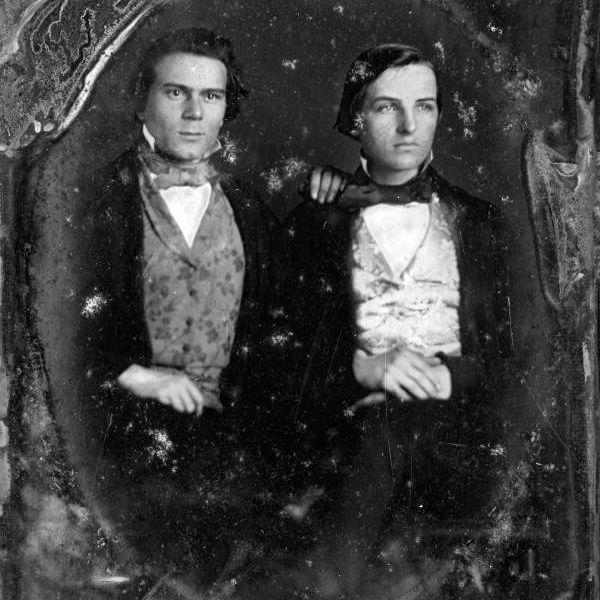
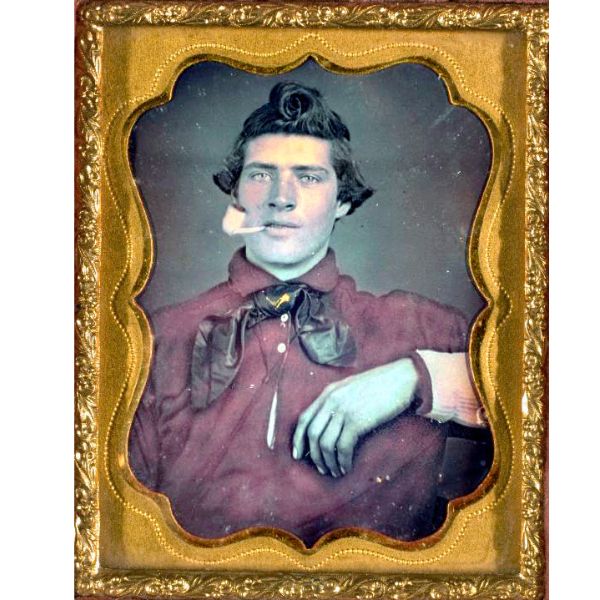
Hairstyles of the decade reflected the overall trend towards a more polished appearance. Many men styled their hair with macassar oil, wearing it long on top and combed into a high wave at the front. This fashion reached its peak mid-decade, leading to the widespread use of "antimacassars" - protective cloths draped over chairs and sofas to prevent oil stains.
As the 1850s drew to a close, hair trends began to shift. Men increasingly wore their hair parted and slicked back, with a length that reached the collar and covered the ears. Facial hair, too, saw changes, with clean-shaven faces giving way to beards along the jawline or narrow goatees.
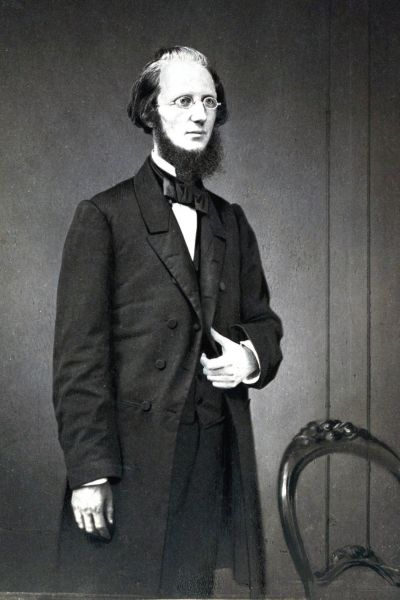

The Working Man's Wardrobe
While high fashion set the tone for the era and the rise of ready-to-wear clothing made fashionable attire more accessible to the working classes, most daily wear remained focused on durability and function.
Ready-to-wear loose shirts, often featuring a plain band collar and half-button placket, became affordable options for workwear. These shirts came in a variety of solid colors and stripes, typically worn tucked into pants and under a vest. Men working outdoors, particularly in the American West, often eschewed the vest, appearing in just shirt, pants, and suspenders.
For those engaged in heavy labor or agricultural work, the smock frock - made from sturdy cotton or linen - continued to serve as a protective outer layer. This garment, a holdover from earlier decades, showcased the persistence of practical clothing even as fashion evolved.



1850s Summary
The 1850s stand as a pivotal moment in the history of men's fashion. Technological innovations, from the sewing machine to synthetic dyes, revolutionized clothing production which ushered in a democratization of fashion. Ready to wear clothing brought style within reach of a broader swath of society and the silhouette of the well-dressed gentleman evolved from the narrow, constrained look of the early decade to a fuller, more comfortable style.







